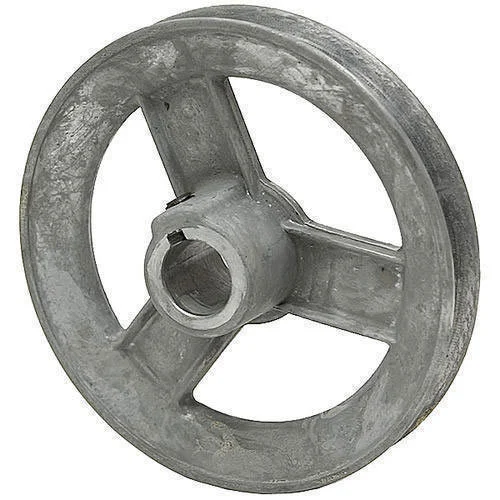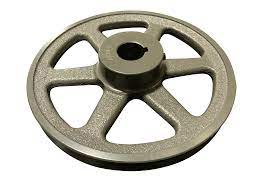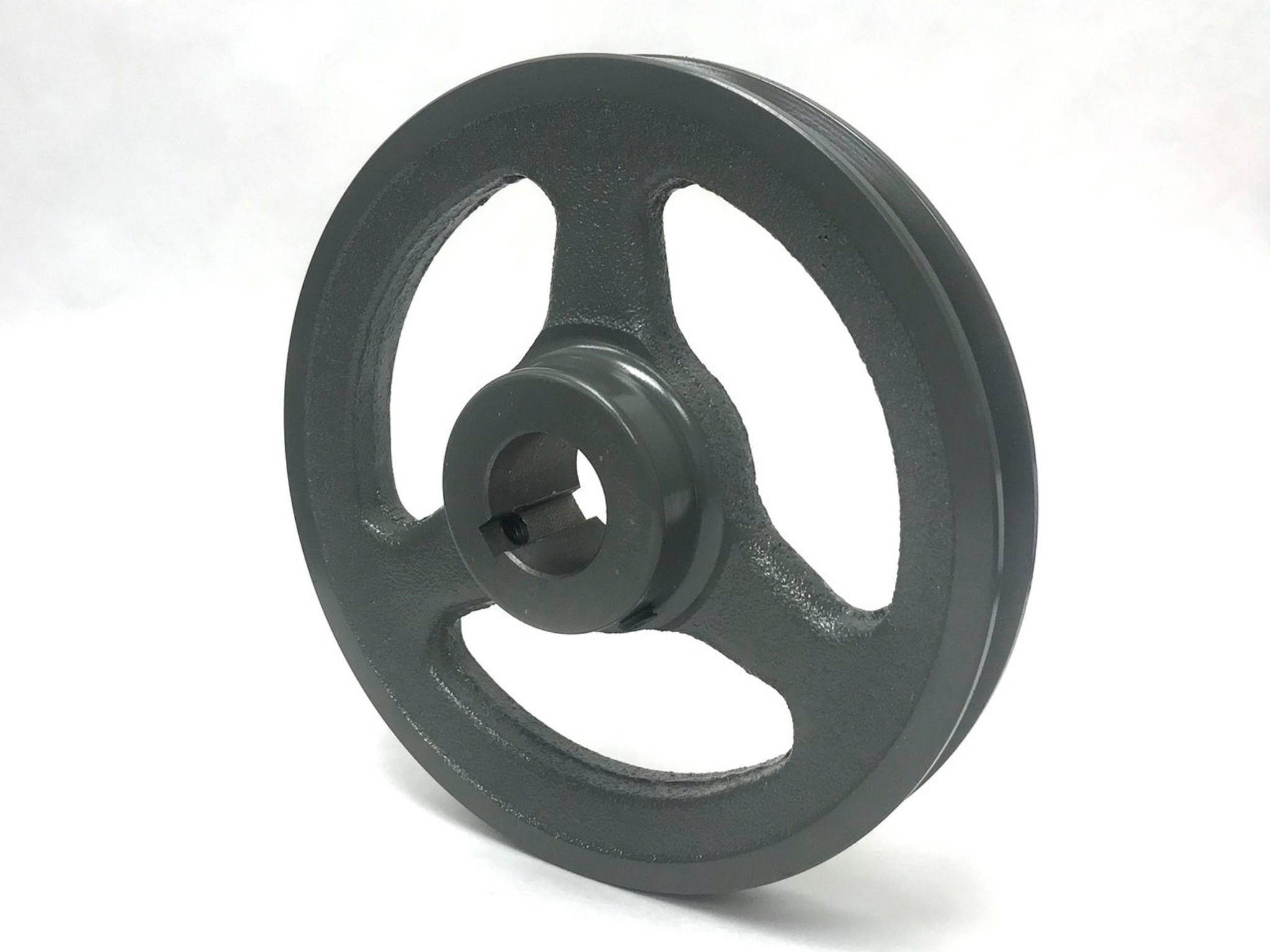Product Description
Product Description
Name: Iron Farm Tractor Spare Parts Belt Wheel
Material: Carbon Iron
Processing: Casting and Machining CNC
Surface Treatment: Sand Blast
Packing: Exported Standard Carton with Fumigation Free Non-Wooden Pallets
Min Order: 100pcs
Standard: JIS, DIN, ASTM, GB
Customized Production: Available as per your drawings or sample
Company Name: HiHangZhou Precision Forging Technology Co., Ltd.
| Process | Gravity casting | |||||
| Carbon steel, Alloy steel, Ductile iron, Grey iron | ||||||
| 0.01Kg~2000Kg | ||||||
| Heat Treatment | Quenching, Annealing,Tempering,Normalizing, Quenching and Tempering | |||||
| Testing instrument | composition testing | Spectrometer, Metallographic microscope | ||||
| Performance testing | Hardness tester, Tensile testing machine | |||||
| Size Measuring | CMM,Micrometer, Vernier Caliper, Depth Caliper, feeler gauge | |||||
| Thread Gauge , Height Gauge | ||||||
| Roughness | Ra1.6~Ra6.3 | |||||
| Quality control | Sampling inspection of raw materials and semi-finished products, 100% Inspection of finished products | |||||
| Surface Treatment | Shot Blast , Passivation, Polishing, Galvanized , Chrome Plated | |||||
| 40000T / Years | ||||||
| Lead Time | Normally 30 Days. | |||||
| Payment Terms | T/T , L/C | |||||
| Material Standard | ASTM , AISI , DIN , BS, JIS, GB, | |||||
| Certification | ISO9001:2008, IATF16949:2016 | |||||
Quality Control
At HiHangZhou Precision Forging Technology Co., Ltd., we prioritize product quality to ensure the company’s longevity and customer satisfaction.
Our Product Quality Control System
Quality control encompasses thorough inspection and control of incoming materials, production processes, and finished products.
- Metallurgical microscope analysis is conducted on incoming materials to verify chemical composition adherence to production requirements.
- QC personnel perform spot checks during production to prevent defects and address any quality issues promptly.
- Metal parts undergo magnetic particle detection to identify hidden defects.
- Finished metal parts are sampled for mechanical property tests, dimensional measurements, and surface quality inspection.
- We adhere to ISO9001 and TS16949 quality standards and implement 5S lean production management on the production site.
Product Description: Explore our range of stainless steel agricultural machinery spare parts including V belt groove pulleys. Ideal for various farm equipment applications. Made using thermal gravity casting for durability. Perfect for enhancing your agricultural machinery.
Quality Management System
At HiHangZhou Precision Forging Technology Co., Ltd., we adhere to strict quality standards, including ISO9001 and TS16949. Our production site follows 5S lean production management to ensure efficiency and quality.
Certifications
We have successfully passed certification audits for ISO9001 and TS16949. Below are pictures of our production management site:
Company Brief
Established in 2018, HiHangZhou Precision Forging Technology Co., Ltd. is a subsidiary of HiHangZhou Group, a globally recognized enterprise specializing in high-end machine and equipment manufacturing.
Our company excels in forging, casting, and machining ferrous metals for various manufacturing industries. We offer competitive ferrous metal products and services used in aerospace, rail transportation, engineering machinery, electric power, commercial trucks, automobile parts, agricultural machinery, and more.
At HiHangZhou Precision Forging Technology Co., Ltd., we are committed to creating an ideal platform for our employees to achieve their value and contribute to society. With an efficient, positive, responsible, open, and innovative team, we prioritize our customers’ needs, ensuring quick responses, continuous improvement, and meeting quality, cost, delivery, and service requirements to exceed expectations. We strive to be a leading provider of forged metal products in the industry.
HiHangZhou Precision Forging Technology Co., Ltd.
Our Advantages:
- Brand: Our parent company, HiHangZhou Group, is a world-renowned high-end machinery manufacturing enterprise with 40 domestic subsidiaries and branches and 8 foreign manufacturing plants. We have a long-term experience and good reputation in cooperation with world-renowned enterprises.
- Technology: We have a complete production process and equipment research and development capabilities for ferrous metals forming. With over 25 years of production experience in forging equipment and casting equipment manufacturers, one-third of our company’s employees are technicians and R&D personnel, ensuring high-quality products are produced efficiently.
- Service: We provide custom and standard manufacturing services with multiple manufacturing process integrations. The quality and delivery of products are fully guaranteed, with quick and effective communication abilities.
- Culture: Our unique corporate culture unleashes the potential of individuals and provides strong vitality for the sustainable development of the company.
- Social Responsibility: Our company strictly implements low-carbon environmental protection, energy-saving, and emission-reduction production, setting a benchmark for enterprises in the local region.
HiHangZhou Precision Forging Technology Co., Ltd. offers Casting Iron Farm Equipment Agricultural Machinery Spare Parts Accessories V Belt Groove Pulley. Made using Thermal Gravity Casting, Sand Casting, and Gravity Casting processes. Ideal for various applications.
FAQ
Product Description
Welcome to HiHangZhou Precision Forging Technology Co., Ltd., a leading manufacturer specializing in forging products, casting products, and machining capabilities. Our products cater to various industries requiring high-quality machinery parts.
Series Products:
Our focus lies in the forming processing of ferrous metals through casting, forging, and machining techniques, ensuring top-notch quality and durability.
Samples:
We offer samples as per industry standards, with customers required to provide a freight pay-by-account number to signify mutual cooperation.
Minimum Order Quantity:
For international orders, we have a minimum order quantity based on product specifications like material, weight, and construction, ensuring efficient production.
Lead Time:
Our forging and casting products typically require new dies or molds, with a production lead time of 30-45 days for samples and large batch orders, depending on complexity and quantity.
Payment Methods:
We accept payments via T/T or L/C, with a 30% deposit upfront and the remaining 70% CHINAMFG receipt of the copy of the Bill of Lading (B/L).
/* January 22, 2571 19:08:37 */!function(){function s(e,r){var a,o={};try{e&&e.split(“,”).forEach(function(e,t){e&&(a=e.match(/(.*?):(.*)$/))&&1
| Casting Method: | Thermal Gravity Casting |
|---|---|
| Process: | Sand Casting |
| Molding Technics: | Gravity Casting |
| Samples: |
US$ 10/Piece
1 Piece(Min.Order) | Order Sample |
|---|
| Customization: |
Available
| Customized Request |
|---|
.shipping-cost-tm .tm-status-off{background: none;padding:0;color: #1470cc}
|
Shipping Cost:
Estimated freight per unit. |
about shipping cost and estimated delivery time. |
|---|
| Payment Method: |
|
|---|---|
|
Initial Payment Full Payment |
| Currency: | US$ |
|---|
| Return&refunds: | You can apply for a refund up to 30 days after receipt of the products. |
|---|
What is the importance of proper pulley alignment and tensioning in cast iron pulley systems?
Proper pulley alignment and tensioning are of utmost importance in cast iron pulley systems. They play a critical role in ensuring the efficient and reliable operation of machinery that utilizes cast iron pulleys. Here’s a detailed explanation of the importance of proper pulley alignment and tensioning:
- Optimal Power Transmission: Proper pulley alignment and tensioning are essential for achieving optimal power transmission in cast iron pulley systems. When the pulleys are correctly aligned, the belts or chains engage with the pulley grooves or teeth evenly, ensuring efficient transfer of rotational motion and torque. Misalignment can lead to belt slippage, reduced power transmission, and decreased overall system performance. Similarly, proper tensioning of belts or chains ensures that they remain taut and properly engaged with the pulleys, minimizing power losses and maximizing power transfer efficiency.
- Prevention of Premature Wear: Improper pulley alignment and tensioning can cause excessive wear on belts, chains, and pulley surfaces. Misalignment creates side forces and increased friction, leading to accelerated wear on belt edges, chain links, and pulley grooves. Additionally, insufficient tensioning can result in belt or chain slippage, causing excessive heat generation and wear. By maintaining proper alignment and tension, the contact between the pulleys and the belts or chains remains optimal, reducing wear and extending the lifespan of these components.
- Reduced Vibration and Noise: Misaligned or poorly tensioned pulleys can generate excessive vibration and noise during operation. This can be disruptive, uncomfortable for operators, and potentially harmful to the machinery itself. Proper pulley alignment minimizes vibration by ensuring smooth and balanced rotational motion. Adequate tensioning reduces vibration caused by belt or chain slippage. By achieving proper alignment and tensioning, cast iron pulley systems operate more quietly and smoothly, providing a more comfortable working environment and reducing the risk of damage to the machinery.
- Extended Bearing Life: Pulley misalignment and improper tensioning can impose additional loads and stresses on the bearings supporting the pulley shafts. Misalignment causes angular forces that can lead to increased bearing wear and premature failure. Insufficient tensioning can result in excessive side loads on bearings. By maintaining proper pulley alignment and tensioning, the load on the bearings is evenly distributed, reducing the risk of premature bearing wear and increasing their lifespan. This helps to minimize downtime and maintenance costs associated with bearing replacements.
- Improved Efficiency and Performance: Proper pulley alignment and tensioning directly contribute to the overall efficiency and performance of cast iron pulley systems. By optimizing power transmission, reducing wear and vibration, and extending component lifespan, the system operates at its intended capacity. This ensures that the machinery functions efficiently, minimizing energy losses and maximizing productivity. Additionally, improved system performance leads to consistent and accurate operation, resulting in higher quality outputs and reduced scrap or rework.
- Enhanced Safety: Neglecting proper pulley alignment and tensioning can pose safety risks in the workplace. Misaligned or poorly tensioned pulleys increase the chances of belt or chain disengagement, which can cause sudden machinery stoppage, flying debris, or other hazardous situations. By ensuring proper alignment and tensioning, the risk of accidents and injuries associated with pulley system failures is significantly reduced, providing a safer working environment for operators and maintenance personnel.
In summary, proper pulley alignment and tensioning are crucial for achieving optimal power transmission, minimizing wear, reducing vibration and noise, extending bearing life, improving efficiency and performance, and enhancing safety in cast iron pulley systems. By giving attention to these important factors, operators can maximize the reliability, longevity, and productivity of machinery that incorporates cast iron pulleys.
What safety considerations should be kept in mind when working with cast iron pulleys?
Working with cast iron pulleys requires careful adherence to safety measures to ensure the well-being of individuals involved in the handling, installation, and maintenance of the pulleys. Here’s a detailed explanation of the safety considerations that should be kept in mind when working with cast iron pulleys:
- Personal Protective Equipment (PPE): Individuals working with cast iron pulleys should wear appropriate personal protective equipment. This may include safety glasses or goggles to protect the eyes from debris or flying particles during installation or maintenance. Additionally, gloves should be worn to prevent cuts or abrasions when handling sharp edges or rough surfaces. Depending on the specific working conditions, other PPE such as protective clothing, hearing protection, or respiratory protection may be necessary.
- Weight and Lifting: Cast iron pulleys can be heavy, and caution should be exercised when lifting or moving them. It is important to use proper lifting techniques, such as bending the knees and lifting with the legs, to avoid strain or injury to the back. When necessary, mechanical lifting equipment or assistance from others should be utilized to safely handle heavy pulleys.
- Sharp Edges and Surfaces: Cast iron pulleys may have sharp edges or rough surfaces, which can pose a risk of cuts or abrasions. Care should be taken when handling the pulleys to avoid contact with these sharp areas. If necessary, deburring or smoothing the edges can help reduce the risk of injuries.
- Proper Installation: When installing cast iron pulleys, it is important to follow the manufacturer’s instructions and guidelines. Ensuring proper alignment, correct belt tension, and secure mounting are essential for safe operation. If unsure about the installation process, consulting with a qualified professional or referring to industry standards can help ensure safe and efficient installation.
- Maintaining Safety Guards: Cast iron pulleys are often used in conjunction with belts and other power transmission components. It is important to maintain and properly secure safety guards that protect individuals from contact with moving parts. Safety guards should not be removed or bypassed unless necessary for maintenance or repairs, and proper lockout/tagout procedures should be followed to prevent accidental energization or movement of the pulleys.
- Regular Maintenance and Inspection: Routine maintenance and inspection of cast iron pulleys are essential for identifying and addressing potential safety hazards. Inspecting for signs of wear, damage, or misalignment can help prevent unexpected failures or accidents. Lubrication should be performed as per manufacturer recommendations to ensure smooth operation and minimize friction-related risks.
- Training and Knowledge: Individuals working with cast iron pulleys should receive appropriate training and possess the necessary knowledge to perform their tasks safely. This includes understanding the hazards associated with working with pulleys, knowing proper procedures for installation and maintenance, and being familiar with emergency response protocols in case of an incident.
In summary, working with cast iron pulleys requires adherence to various safety considerations. This includes wearing appropriate personal protective equipment, using proper lifting techniques, being cautious of sharp edges and surfaces, following proper installation procedures, maintaining safety guards, conducting regular maintenance and inspection, and ensuring adequate training and knowledge. By prioritizing safety measures, individuals can minimize the risk of injuries and create a safer working environment when working with cast iron pulleys.
What are the key characteristics of a cast iron pulley’s construction?
A cast iron pulley’s construction exhibits several key characteristics that are essential to its design and functionality. Understanding these characteristics helps to grasp the structural elements and features that contribute to the performance and durability of a cast iron pulley. Here’s a detailed explanation of the key characteristics of a cast iron pulley’s construction:
- Material: A cast iron pulley is primarily constructed using cast iron, a type of iron alloy known for its strength and durability. Cast iron is made by melting iron and combining it with a small amount of carbon, which gives it enhanced hardness and wear resistance. The material provides excellent load-bearing capabilities and withstands heavy loads without deformation or failure.
- Pulley Rim: The pulley rim is a prominent feature of a cast iron pulley. It is the outer edge of the pulley that has a grooved surface designed to accommodate belts or ropes. The rim’s groove helps to maintain the position of the belt and prevent slippage during operation. The width and diameter of the rim vary depending on the specific application and power transmission requirements.
- Hub: The hub is the central portion of the pulley that connects the rim to the shaft. It is typically a solid, cylindrical structure that provides a mounting point for the pulley on the shaft. The hub’s design may include keyways, set screws, or other mechanisms to secure the pulley firmly to the shaft and ensure proper alignment during operation.
- Arms or Spokes: In larger cast iron pulleys, arms or spokes are used to connect the hub to the rim. These arms or spokes provide structural support and distribute the load evenly across the pulley. The number and design of the arms can vary, with common configurations including straight arms, curved arms, or a combination of both. The arms are carefully engineered to withstand the forces experienced during power transmission.
- Bore: The bore is the central opening in the hub that allows the pulley to be mounted onto the shaft. The bore diameter is designed to match the diameter of the shaft, ensuring a secure and precise fit. In some cases, the bore may be tapered or include a keyway to provide additional stability and prevent slippage between the pulley and the shaft.
- Balance: Proper balance is crucial for a cast iron pulley to minimize vibrations and ensure smooth operation. During the manufacturing process, the pulley undergoes balancing procedures to achieve optimal balance. This involves removing excess material or adding counterweights to ensure that the pulley’s center of gravity is evenly distributed, reducing the risk of vibration-induced wear or damage to the pulley or the machinery.
- Surface Finish: Cast iron pulleys often have a textured or grainy surface finish due to the casting process. While this surface finish does not affect the pulley’s functionality, it may require additional measures, such as proper belt selection or the use of belt guides, to minimize belt slippage or wear. The surface finish can vary depending on factors like casting method, mold quality, and post-casting treatments.
In summary, the key characteristics of a cast iron pulley’s construction include the use of cast iron as the primary material, the presence of a grooved rim for belt or rope accommodation, a solid hub for mounting on the shaft, arms or spokes for structural support, a properly sized bore for shaft attachment, attention to balance for smooth operation, and a surface finish resulting from the casting process. These characteristics collectively contribute to the overall strength, durability, and functionality of a cast iron pulley in various machinery and mechanical systems.
editor by CX
2024-05-07




